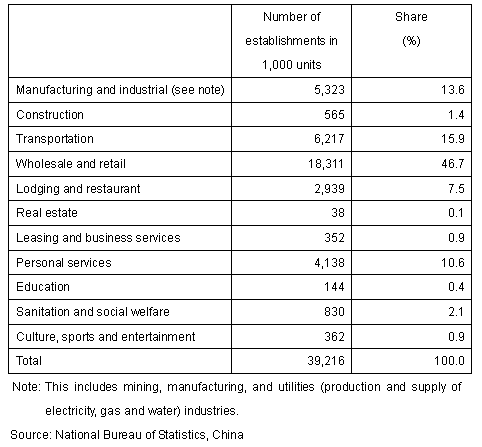In China, the results of the "First National Economic Census" covering the secondary and tertiary sectors have been published in succession. They provide extremely valuable information in grasping the actual state of the Chinese economy after years of pervasive mistrust of China's economic statistics. Among the released figures are not only GDP, a measure of the economy's size, but also a number of other indicators showing how the economic structure has changed along with economic development and transition to a market economy.
The census found that China's GDP in 2004 stood at 15.9878 trillion yuan, 16.8% larger than the previously released figure. Accordingly, per capita GDP was revised upward from the previous $1,276 to $1,490. As a result, China has become the sixth largest economy in the world with its GDP at $1.93 trillion, surpassing Italy at $1.67 trillion. Considering its continuing high growth, it is likely that China will further move up in the global GDP ranking in 2005, replacing France as the fifth largest economy. Based on the census figures, the Chinese government plans to review and make retrospective adjustments to the GDP statistics from 1993 onward. Not only the size of GDP but also the growth rates will be made subject to substantial upward revisions. In particular, it is highly likely that the annual growth rate of GDP from 2003 onward, a period in which the Chinese economy was said to be overheating, was actually in double digits.
The size of the Chinese GDP listed in official government statistics has long been subject to considerable skepticism, but in two contradictory ways with one school of skeptics suspecting overstatements and another pointing to the possibility of understatements. As a ground for their overstatement argument, skeptics have cited the fact that provincial governments are using the growth rates of local economy as one of the important measurements in valuating the performance of senior officials. Thus, they argued, there exists a strong tendency among local government officials to substantially overestimate economic performance figures in a manner tantamount to "fraudulent window-dressing." On the other hand, those suspecting understatements have contended that government statistics were not sufficiently reflecting the situation of the non-state-owned sector that has been performing fairly well, while having a relatively good grasp of the situation of the state-owned sector that has been in doldrums for many years. Though acknowledging some cases of overstatements, the census results have virtually declared a victory for the understatement argument.
The revision of GDP figures is primarily attributable to substantial upward revision of service-sector figures. China's GDP for 2004 was revised upward by 2.3 trillion yuan, of which 93% or 2.13 trillion yuan was from the service sectors. One reason behind this is that China's conventional statistics system has not properly captured the high growth of individually-owned businesses in the service sector. With the revision, the service sector has come to represent 40.7% of the GDP, up from 31.9% prior to the revision, whereas the secondary sector -- primarily comprising manufacturing and industrial businesses -- has declined in share from 52.9% to 46.2%. It has been widely observed that the backbone of national economy shifts from the primary sector (agriculture) to the secondary (manufacturing and industrial), then to tertiary (service) in tandem with economic development (Petty-Clark's Law). Based on the pre-census official statistics, it appeared as if China were an exception to the law. However, as shown by the census results, it was nothing but a misrepresentation of the facts.
Meanwhile, what has become succinctly clear in the census is the rise of non-state-owned enterprises as the leading player in the market economy. The results of the census are in stark contrast to those of the "Second Work Unit Census" conducted in 2001. Reflecting the progress of privatization, the number of state-owned enterprises decreased 48.2% to 192,000, while the number of privately-owned enterprises rose 49.7% to 1.982 million. Meanwhile, the number of individually-owned businesses stood at 39.22 million in 2004, primarily concentrated in such areas as wholesale and retail, manufacturing and industrial, transport, personal services, and lodging and restaurants ( table ). The number of employees (including owners) working at individually-owned businesses totaled 94.22 million, far greater than the previously announced figure of 45.87 million (according to the China Statistical Yearbook ), accounting for 30.5% of total employees in the secondary and tertiary sectors. In the industrial sector, which includes mining, manufacturing and public utilities, the number of employees working for privately owned enterprises came to 33.71 million. Together with 20.58 million working for foreign-owned (including Taiwanese, Hong Kong and Macao) companies, they account for 56.3% of total employees, exceeding by far the 13.4% working for state-owned enterprises (including those wholly owned by the state).
As such, state-owned enterprises in China are losing their dominant position, which is being taken up by the fast growing private sector economy. The Chinese government is pledging to maintain "public ownership of production means," which is supposed to be the backbone of socialism. Such official lines from the government, however, are contradicted by reality and it is no exaggeration to say that China, in its pursuit of a market economy, has now reached a stage where one must declare an end to socialism.



